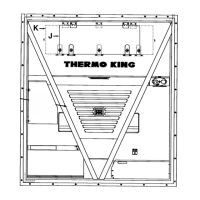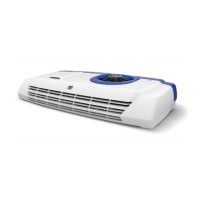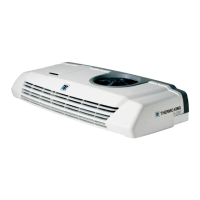Refrigeration Maintenance and Service Operations
142
2. If the vacuum level appears to stall above
500 microns, back seat the discharge service
valve and observe the micron meter.
• A drop in pressure indicates that the
compressor oil is out-gassing and further
evacuation is necessary.
• An increase in pressure indicates that a
leak exists or there is moisture in the
system. Perform a pressure rise test and
evaluate.
3. Close valve V1 when the desired vacuum
level has been reached.
4. Wait five minutes and read the micron meter.
• A system that is leak free and dry will
remain below 2000 microns for 5 minutes.
• A system that rises above 2000 microns
but stabilizes below atmospheric pressure
is probably contaminated with moisture or
has refrigerant out-gassing from the
compressor oil. Additional evacuation is
required.
• A system that continues to rise without
stabilizing has a leak and must be repaired.
5. If the vacuum level remained below
2000 microns for 5 minutes, the unit is ready
to charge. See “Charging the System with
Refrigerant” on page 143.
Pressure Rise Test
Evacuate the system and close valve V1. With
valves V3 and V4 open, the pump is isolated and
the system is held under a vacuum. If the micron
meter rises, one of the following conditions exist:
• Leak: Watch the movement of the micron
meter needle. If the needle continues to rise
until it reaches atmospheric pressure, it is an
indication that a leak exists somewhere in the
system. When a leak is in a system, the
vacuum will eventually stabilize at
atmospheric pressure (see “Pressure Rise Test
Evaluation” in this chapter).
• Moisture: When the needle indicates a rise and
then stabilizes at a level below atmospheric
pressure, it is an indication that the system is
vacuum tight, but is still wet and requires
additional dehydration and pumping time. See
Figure 52 “Pressure Rise Levels Off After
Evacuation Indicates Moisture in System”.
1. Close the vacuum valve and watch the
movement of vacuum gauge needle. If needle
continues to rise, this is an indication that a
leak exists in the unit or connecting line. The
leak must then be located and eliminated.
2. Time
3. Pressure (Vacuum)
4. Atmospheric Pressure
Figure 51: Constant Pressure Rise After
Evacuation Indicates System Leak
1. Close the vacuum valve and watch the
movement of vacuum gauge needle. If needle
shows a pressure rise but finally levels off to a
constant pressure, the system still contains too
much moisture. Dehydration and additional
evacuation time are required.
2. Time
3. Pressure (Vacuum)
4. Atmospheric Pressure
Figure 52: Pressure Rise Levels Off After
Evacuation Indicates Moisture in System
AXA0191
AXA0192

